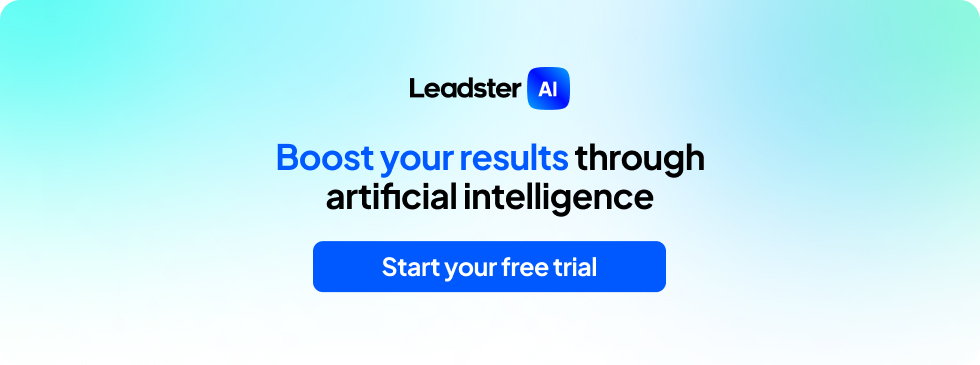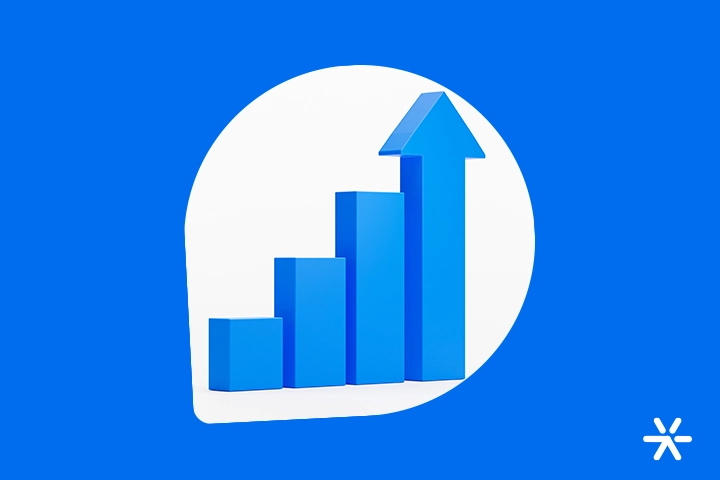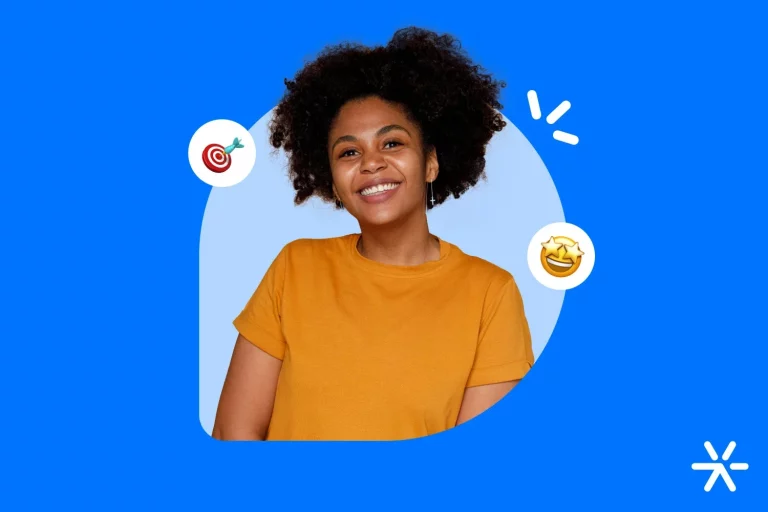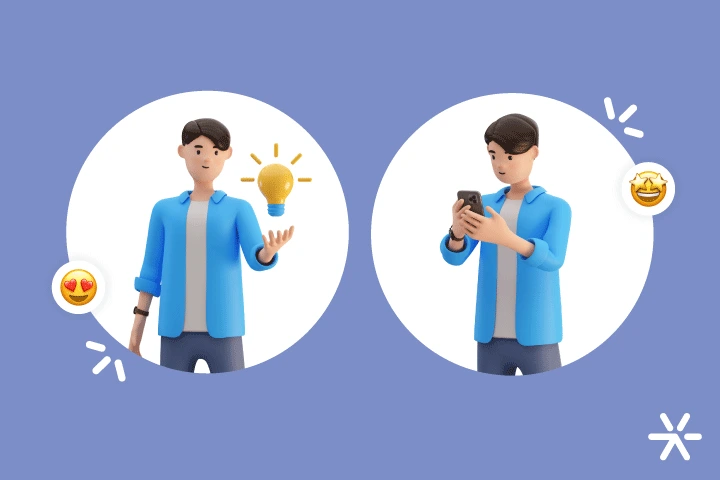25 Digital Marketing Tips to Sell More Today!
So, are you looking for some digital marketing tips to start putting your strategy into action?
Actually, maybe your strategy is already up and running and you just want to make sure everything’s on the right track—and maybe figure out where you can improve, right?
In either case, this is the right article for you. We gathered the team here at Leadster and put together this list of 26 digital marketing tips that cover a wide range of important areas—from general strategy to social media.
But before we dive in, let’s talk a bit more about the digital marketing landscape in 2023 and how to make the most of these tips.
Ready? Let’s get started.
Where to Start with Digital Marketing in 2023?

If you’re just starting a digital marketing strategy in 2023, there are a few things you need to know that will really help you along the way.
First: a lot is changing this year. With the rise of artificial intelligence tools, digital marketing teams are becoming smaller and more specialized.
Thanks to digital marketing and technological advancements, a lot has changed. Much of the work can now be done by a smaller team—4 or 5 people—and the need for highly specialized and expensive equipment is fading.
AI accelerates this even further. Using AI tools, one person can now deliver a complete digital marketing service, without even needing to hire freelancers.
This drives down costs and democratizes access to more specialized production, like video content.
🔎 Also read: How to Manage a Marketing Agency
2023 is an amazing year for anyone getting started in marketing. You’re free to test different work formats—no need to start your career in an agency, no need for a big budget, specialists, or even a team.
You can shape your career however you want.
25 Digital Marketing Tips for Beginners and Veterans
These tips are useful both for digital marketing beginners and for those who already have clients and active strategies.
In the daily rush, even the most experienced digital marketers let some things slip through the cracks. That’s completely normal—no marketing professional is 100% satisfied.
There’s always something missing—the hard part is stopping to figure out what it is. That’s where these digital marketing tips come in.
And for beginners, many start with what they know, get comfortable, and end up ignoring other important strategies. If it’s working now, why change?
To keep improving, that’s why. Every result you’re not achieving but could be is a missed opportunity.
So check out these 25 marketing tips that could be key to any strategy. Why not create a checklist and see what you might be missing?
🔎 Also read: How to Create a Good Client Budget and Close More Deals
1 – Know the Two Main Types of Marketing
There are many kinds of marketing. Some are niche-specific—like marketing for real estate, construction companies, solar panel providers, and so on.
Then there are the more general categories. These are the ones you need to understand and master.
Marketing branches out in many directions. There are as many marketing types as there are media: YouTube marketing, social media marketing, TV marketing, trade marketing, event marketing, etc.
But the two most important approaches today are inbound marketing and outbound marketing.
Outbound is also known as interruption marketing: the customer receives a promotional message without asking for it.
Inbound is known as attraction marketing: the customer searches for information and discovers your brand through it.
To better understand both tactics, check out our articles on the topic:
➡️ Outbound Marketing: What It Is and When It’s the Best Strategy
➡️ Inbound Marketing in 2023: A Guide to Starting or Expanding
2 – Study the Marketing and Sales Funnel
For a digital marketing strategy to truly work in 2023, you need to understand, build, and implement your marketing and sales funnel.
The funnel represents the journey your customer takes before making a purchase. It starts at the top with a visitor or someone showing interest, and ends with a customer.
Most of the time, the marketing funnel is used in inbound strategies. It requires solid content marketing work to generate leads, which are then nurtured via email marketing until they become Marketing Qualified Leads (MQLs).
After that stage, your dedicated sales team steps in to qualify the lead even further until they’re ready for an offer.
A marketing and sales funnel’s main role is to organize your sales process. Think of it as a well-calibrated machine that turns visitors into customers.
Check out some helpful links to learn more about building and designing your sales funnel:
- Examples of real funnels: In this article, we show real-world funnels from working businesses to inspire you;
- Lead organization tools: Use platforms like RD Station, HubSpot, or Lahar to capture and manage leads;
- Sales software: You’ll need these to manage the bottom of the funnel. They offer more customization than inbound platforms, which focus more on the top and middle of the funnel. Pipedrive and Zoho CRM are top picks, with Pipedrive being more sales-oriented;
- Track your conversion channels: Knowing how to use Google Analytics is essential. It helps you understand your main traffic sources and where you should boost your presence and investment;
Start Learning About the Flywheel Method
While inbound marketing relies entirely on the funnel, there’s a newer methodology that updates the concept.
It’s called the flywheel method, which replaces the funnel with a circle—a wheel, as the name suggests.
The flywheel method has three phases: attract, engage, and delight. The focus is on customer experience.
The idea is that traditional inbound marketing spreads its focus across many stages: generating traffic, generating leads, nurturing leads, qualifying leads, creating opportunities, and finally making a sale.
As a result, the customer experience—although part of the journey—is often neglected by companies using inbound.
Flywheel doesn’t ignore sales but instead invests in the most powerful sales engine of all: an excellent product.
3 – Make Lead Generation Your Top Priority
As you study the marketing and sales funnel, you’ll realize that without leads, there are no sales.
Generating qualified leads is the top digital marketing strategy in 2023. Every company working online has this as their #1 priority.
Because leads are your future sales. And when your funnel is well-structured, your sales volume is directly tied to the number of leads you generate.
For example, if you generate 1,000 leads a month but make only 5 sales, it’s totally possible to optimize your funnel and sales process to increase that number.
But if you’re generating only 100 leads a month, there’s a cap to how much you can sell—you might struggle to even hit 5, depending on your business type.
So lead generation should be your top priority. But how do you generate leads early on in your digital marketing strategy?
4 – Always Create Content
Remember when I said inbound marketing is attraction marketing? That means your potential customers—your prospects—need to find you somehow, right?
Let’s say you run an online shoe store. How do you make sure your customer finds you every time they search for something shoe-related, on any platform?
Through content marketing.
A strong content marketing strategy anticipates your prospect’s needs by understanding what they (defined in your strategy as your target audience, persona, or ICP) are searching for online. What are their questions?
On Google, this starts with keyword research—the most basic and reliable way to find commonly searched terms.
On social media, you’ll need to analyze competitors, join groups where your prospects gather, and understand their concerns. From there, you’ll create your content.
Eventually, your prospects will become leads via lead magnets. This article explains exactly what those are.
5 – Understand What You Can Do
This is one of those digital marketing tips you rarely see online.
Everyone tells you to do a million things, but very few suggest taking it slow, testing the waters, and expanding gradually.
All the digital marketing tips in this article come with action recommendations you can implement—or at least plan—today. But that doesn’t mean you need to do everything at once.
Do what you can today, but do it well. It’s much better to have great success in a few actions than little success in many.
6 – Don’t Work Without Clear Goals
Every action you take needs to have key goals. At this early stage of the digital marketing tips, let’s talk about more general goals. Later in the article, we’ll talk about how to quantify and standardize them.
When you start producing content, for example, you’ll need a general goal: “Within a year, I want to generate at least 5,000 monthly visitors from organic traffic.”
Another general goal that pairs well with that: “I want to turn at least 10% of those monthly visitors into leads.”
When you start a paid media campaign, same logic: “I want to generate R$100,000 in sales for every R$10,000 invested.”
These small goals open the door to various strategies—as long as you keep a clear direction. Over time, you’ll learn how to create KPIs and OKRs to measure your efficiency.
7 – Don’t Work Without Analytics
For a marketing professional, working without analytics is like a carpenter working in the dark.
Sure, sometimes you might get lucky and hit the nail on the head. But it’ll be pure luck—and you won’t be able to repeat the result because you won’t know what you did right.
Google Analytics 4 is very accessible, free, and gives you everything you need to know about your website—how many visitors you have, where they come from, your most visited pages, etc.
It also provides information about your Google Ads campaigns: how much you’re spending, how many clicks they generate, how many clicks turned into sales, and more.
🤿 Go deeper: Google Analytics 4 – how to set it up and use it
Every ad platform has its own type of analytics. YouTube, Instagram, Facebook, Twitter, TikTok, and even marketplaces like Amazon and Mercado Livre.
We have an article on data-driven marketing that helps you get familiar with most analytics tools available. It’s definitely worth a read. 🤓
8 – Always Try to Get a Case Study as Soon as Possible
Here’s another marketing tip you won’t find so easily online. This one is more targeted toward freelancers and small marketing agencies.
A successful case study is your strongest sales argument. Every time you land a new client, identify where it’ll be easiest to generate a quick case study—and go all in to make it happen fast.
For example: you sign with a highly niche company, like a premium knife manufacturer for restaurant chefs.
Doing some Google and keyword research, you notice that content marketing in that niche is weak, but there’s a decent amount of keyword search volume.
That means a solid content marketing strategy can quickly drive a lot of traffic. There’s your case study.
Even if you offer other services, give special attention to the one that will bring a fast case study. The more success stories you have, the easier it becomes to sell your services to new clients.

9 – Don’t Start Alone
Out of all the marketing tips so far, this one’s the broadest—it applies to businesses, agencies, and independent professionals.
Never start a marketing strategy completely alone. You don’t need to have a full team or hire an agency right off the bat, but it’s important to at least build a solid network of professionals who understand a bit about marketing and sales.
Why? Because you never know when you’ll need help. Let’s say you started a content marketing and lead generation strategy on your own.
These tend to deliver long-term results, but you can’t predict when success will hit. One day you have 20 leads in your database, and the next, 500. Now what? Are your automations set up? Are the leads being followed up with in time?
Having a solid team from the start is the ideal route. But even if you don’t, you’ll need a good network for when you need professionals urgently.
10 – Start with Inbound Marketing
In the first digital marketing tip, we discussed how important it is to understand the two main types of marketing: inbound and outbound.
But one key piece of advice is to start with inbound marketing, especially if you’re new to the field.
Inbound has lower costs and results are organic—which means they don’t depend on constant investment.
Inbound marketing is also a universal strategy, meaning the earlier you master it, the more success you’ll find over time.
This also applies to the time it takes to see results. If you start with inbound earlier, even gradually, you’re already setting yourself on the path that leads to future success.
Don’t ignore outbound entirely, but focus on inbound. Speaking of outbound…
11 – Use Paid Media from the Start
But be careful: don’t rely 100% on it.
It’s very common for brands—even when they’re focusing on content marketing and organic traffic—to also invest in paid media.
Why? Because, as we’ve discussed, inbound marketing is a long-term strategy.
If you need quicker results, setting up some paid media campaigns is a great idea.
Many brands actually combine both strategies: Google Ads to promote blog articles and lead magnets, social media ads for informational content, etc.
12 – Build a Trusted Team
Earlier in the article, we talked about how artificial intelligence can solve some of the major challenges in early-stage digital marketing—especially the lack of a specialized team.
But even though AI tools help a lot, they still have limits. The articles they generate need editing, and you’ll need someone to design your content strategy—something AI isn’t great at yet.
A solid team is essential, and ideally, it should be made up of professionals you trust and know from past experience.
What does that mean? Avoid hiring friends or family. Digital marketing is tough, stressful, and full of setbacks. It’s better to build good professional relationships than risk damaging personal ones.
13 – Invest in Work Management Tools
This is one of the most overlooked digital marketing tips by people just starting out. And surprisingly, even some veterans neglect management tools.
There are many platforms designed to organize your work routine, and they’re absolutely essential for digital marketing, which lives on tight deadlines.
To name a few:
- Asana
- Trello
- Jira
- Studio
- Monday
Among others. They’re not exactly cheap, but they make a huge difference in your daily routine and the results you deliver.
14 – Regularly Analyze Your Clients’ Competitors on Google
In a content marketing strategy focused on Google, you always need to check where your competitors rank for specific keywords.
You’ll also need to analyze the pages that rank well to understand what they do differently from yours—and how hard it’ll be to beat them.
If you work with SEO, you’ll be checking keywords daily and listing your main competitors for each topic. And remember: competitors aren’t just other companies selling the same product.
In content marketing, your competitors are any brands discussing the same topics as you—trying to rank for the same keywords.
Two great tools for analyzing your competitors’ keywords are SEMRush and Ahrefs. They give you a full traffic report, keyword rankings, and even insights into their ads.
They’re a bit pricey, but as you grow in digital marketing, they become indispensable.
15 – Do Keyword Research to Power Your Blog Strategy
In several of our digital marketing tips, we’ve mentioned the need for keyword research. So how about we dive deeper into that next?
Keywords are the terms used by search engine users to find a specific topic. Let’s go back to the previous example: you work in a high-end knife industry.
What does your target audience search for about this? What words do they type into search engines when looking for these topics?
Finding these words is what keyword research is all about. And it’s free: you can use Google’s Keyword Planner, a free tool within Google Ads, to find them.
Writing a blog post is a strategic task, completely aimed at what people are already searching for. Don’t skip this step!
16 – Understand the Long Tail Concept and Long-Tail Keywords
When you’re working with content on the internet, especially on YouTube and blogs, you need to understand the concept of long-tail content.
Basically, when doing your keyword research, it’s a great idea to prioritize the larger keywords. In our knife example, it’s better to use “tungsten knife is better” than just “tungsten knife.”
This is because the more specific your keyword is, the less competition it will have. These are long-tail keywords.
Now, applying the long-tail strategy to content marketing is a bit different. Basically, you need to write as many articles or create as many videos for YouTube as possible.
The idea is that the more content you have, the more views you’ll get. So, instead of dedicating an entire month to writing one huge piece of content, it might be a good idea to write several smaller pieces, each targeting a different keyword.
17 – Create Collaborative Editorial Calendars
Those just starting in digital marketing face a big challenge: expressing your creativity in a way that your client or supervisor can understand and approve.
This becomes easier with an editorial calendar, created right in Google Sheets. In this format, it can be shared, and you can include all the direction for an idea.
With this, your client or supervisor understands what you want to do and who is going to execute the task. The more communication, the better!
18 – Recruit A.I.s to Help You with More Complex Materials
What if you want to make a video but have no idea where to start? You have no images, no script, no narration, nothing! What now?
Artificial intelligence can help you with all these steps. For example, using a tool like Lumen 5, you can offer both blog articles and videos in the same package. AI automatically makes the conversion.
So, instead of rejecting materials due to lack of expertise, do your research first. It’s very likely that some AI can help you.
19 – Create and Track KPIs and OKRs
KPIs are key performance indicators, while OKRs are objectives and key results.
Basically, OKRs are big goals and objectives, directly related to your business goals.
For example: increase my leads by 50%. Increase my lead-to-sales conversion by 100%.
KPIs, on the other hand, are indicators. As such, they need to be measurable, achievable, relevant, and have a set time frame.
The relationship between the two is very intuitive. In this OKR example, you can set various KPIs that will tell you if you’re close to or far from achieving the goal. “Increased website traffic,” “Click-through rate on landing pages,” etc.
For each OKR, set KPIs. And every KPI needs corresponding OKRs.
20 – Do Email Marketing
Something amazing happened between 2010 and today: email, which many believed was dead, has risen from the ashes.
Today, email marketing is the third most widely used digital marketing strategy in the world, according to Hubspot.
The best way to start is by capturing leads and starting email nurturing flows.
The job is simple, cheap, and highly scalable. The same template can be reused to create dozens of emails, and even the same concept can be used in different campaigns.
But just a quick note about sending emails:
21 – Don’t Buy Lead Lists
Buying lead lists is one of the worst things you can do in digital marketing.
First, communicating with people who haven’t given their consent is a violation of the LGPD, and fines are already being applied.
Second, this strategy doesn’t deliver good results. You might buy a list of 5,000 leads, but none of them have interacted with your brand. What are you going to talk about? How will you make a sales pitch?
Lead lists with no interaction with you are harder to sell. And you might get penalized by email providers if too many people mark you as SPAM.
🤿 Deep dive: Lead lists - is it worth buying?
22 – Develop Surveys to Determine Your Persona
Don’t waste time creating personas without at least doing a quick survey.
Such a survey involves various methods, some harder, others much simpler.
If you don’t have the time or money to conduct a full survey, do what you can. Visit your competitors’ physical stores and talk to people and salespeople.
Join Facebook and WhatsApp groups and see what the main concerns of your prospects are.
Over time, you’ll better understand your customer’s needs and pain points, as well as what they believe, how they make purchasing decisions, and even traits of their personality.
This is how you build a persona: with plenty of research and information. Creativity is for other tasks.
23 – Write a Manifesto
Among all the digital marketing tips we’ve prepared, this one is the most fun.
Write a manifesto about your brand, talking more about what you believe in, your ideals, values, worldview, and mission in the business world.
Think of it like a letter to the world and to yourself. With a manifesto in hand, it’s easier to move your business forward without losing the values that connect you to your customers.
It can guide all your communication going forward.
24 – Prioritize Customer Retention
Acquiring new customers is great, but keeping the customers you already have is even better and much cheaper.
This is because there’s a metric called CAC – customer acquisition cost. Basically, every customer has a price, meaning you needed to invest in marketing to close a sale.
Customers who buy more than once reduce your average CAC because you didn’t need to spend much to close the sale. In fact, you’ve already spent it.
25 – Work with Lead Scoring
This is my last digital marketing tip, and also one of the most important.
Lead scoring is related to inbound marketing, more specifically to the middle of the marketing funnel.
When you convert leads, you need a nurturing flow to receive them into your database. They begin receiving automated emails that go deeper into their qualification.
That’s why lead scoring is important. It’s a score that your lead receives as they take actions within your flow.
Once they reach a certain score, they can be approached commercially. They’re now ready to receive an offer.
To learn more about this topic, I recommend reading our article specifically about lead scoring!
So, did these digital marketing tips help you? I hope so!
If you’re a company just starting to sell your products or services online, I highly recommend our article on digital marketing for beginners.
I also recommend that you check out our materials section, where we have various eBooks and tutorials on practically all the points we covered here.
And if you’re an agency, come be part of Leadster’s partnership plan! We work together offering your services to those who need them.
Thank you for reading, and see you in the next article!







